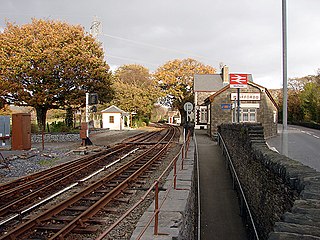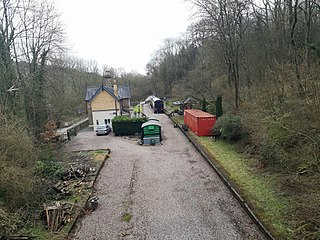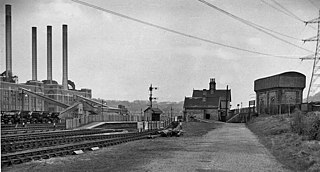
The Severn Valley Railway is a standard gauge heritage railway in Shropshire and Worcestershire, England, named after the company that originally built the railway over which it now operates. The 16-mile (26 km) heritage line runs from Bridgnorth to Kidderminster, following the course of the River Severn along the Severn Valley for much of its route, and crossing the river on the historic Victoria Bridge.

The Dartmouth Steam Railway, formerly known as the Paignton and Dartmouth Steam Railway, is a 6.7-mile (10.8 km) heritage railway on the former Great Western Railway branch line between Paignton and Kingswear in Devon, England. Much of the railway's business is from summer tourists from the resorts of Torbay, who travel to Kingswear, where the Dartmouth Passenger Ferry takes them across the River Dart to Dartmouth.

Minffordd railway station is a pair of adjacent stations on separate lines in Gwynedd, Wales. The mainline station opened as Minfford Junction on 1 August 1872 at the point where the then recently built Aberystwith and Welsh Coast Railway line from Dovey Junction to Pwllheli passes under the earlier narrow gauge Ffestiniog Railway. The latter was built in 1836 to carry dressed slate from Blaenau Ffestiniog to Porthmadog for export by sea, and had carried passengers from 1865 onwards. The station was renamed Minffordd in 1890.

Caldicot railway station is a part of the British railway system owned by Network Rail and is operated by Transport for Wales. It serves the town of Caldicot in Monmouthshire, Wales. It is located between Chepstow and the city of Newport on the Gloucester line, 148 miles 2 chains (238.2 km) from the zero point at Paddington, measured via Stroud. The line to Bristol via the Severn Tunnel runs just to the north but there are no platforms here; however, Severn Tunnel Junction station is within walking distance for those wanting to travel to Bristol.

Arley railway station is a station on the Severn Valley Railway heritage line in Worcestershire, situated just over the River Severn from the village of Upper Arley; a footbridge crosses the river to link the station to the village. The station is about 1⁄2 mile (0.8 km) north of Victoria Bridge, on which the SVR crosses the River Severn.

Highley railway station is a station on the Severn Valley Railway heritage line in Shropshire, near the west bank of the River Severn and just under a mile south-east of the village of Highley. Highley is the only staffed single-platform station on the line. Other stops with one platform are unstaffed halts.

Country Park Halt is an unstaffed request stop on the Severn Valley Railway heritage line in Shropshire, situated near the west bank of the River Severn, about 300 yards north of the footbridge between Highley and Alveley in the Severn Valley.

The GWR Coalport railway station, active 1862–1963, was originally built as a single through platform railway station on the Severn Valley Line serving the village of Coalport in Shropshire, England. By January 1896 an additional platform had been added, thus permitting up and down trains to pass along, with a third platform face behind the up platform to form an east-facing bay. By this time, the goods sidings to the east of the station had been expanded.

Buildwas railway station was an isolated junction railway station on the Wellington to Craven Arms Railway and Severn Valley Railway. Opened on 1 February 1862. Although the station served both the Severn Valley Railway and Wellington to Craven Arms Railway, it was an interchange station in open countryside with no passenger access except by rail.

Jackfield Halt was an unstaffed request stop on the Severn Valley line in Shropshire, England. Originally opened at Jackfield, west of Maw and Company's private sidings in 1934, it comprised a simple wooden platform and shelter.

Berrington railway station was a railway station on the Severn Valley line serving the village of Berrington, Shropshire. It opened in 1862 with a single platform and a siding. By 1894 it had acquired an additional platform along with a signal box and the sidings had been expanded. Despite the name it was actually closer to the neighbouring village of Cross Houses. Although thought by some people to have been closed as part of the Beeching axe in 1963 its planned closure pre-dated his report. The station and its buildings now house a private dwelling.

Eardington Halt, originally named Eardington, is a railway station on the Severn Valley Railway near Eardington, south of Bridgnorth, in Shropshire.

Alveley Halt was a halt on the original Severn Valley Line, situated between the villages of Highley and Alveley, in the English county of Shropshire. The station, which was not re-opened by the heritage Severn Valley Railway, has been replaced by the adjacent Country Park Halt around one-quarter of a mile (0.4 km) up the line.

The Wye Valley Railway was a standard gauge railway that ran for nearly 15 miles (24 km) along the Lower Wye Valley between the towns of Chepstow and Monmouth, crossing several times between Wales and England. Opened on 1 November 1876, it was leased to, and worked by, the Great Western Railway (GWR), before being fully absorbed by the GWR in 1905.
Foley Park Halt was the first stop on the GWR Kidderminster to Bewdley loop line which now forms part of the Severn Valley Railway. It was located in the Kidderminster suburb of Foley Park where the railway went under the A451 Stourport Road. Facilities included a single wooden platform, a ticket booth and a Pagoda Platform Shelter.
Lydbrook Junction railway station is a disused railway station in England opened by the Ross and Monmouth Railway in 1873, it remained open for 91 years until 1964 when the line finally closed to freight, though passenger services ceased in 1959. The station was constructed in the hamlet of Stowfield approximately half a mile from Lydbrook and its viaduct on the Severn and Wye Railway. It was located approximately 4 miles and 34 chains along the railway from Ross-on-Wye station. In 1874 the Severn and Wye Railway opened a branch from Serridge Junction and Cinderford, passenger services commenced in 1875. All passenger trains along the S&W branch were withdrawn from 1929.

Apley Hall is an English Gothic Revival house located in the parish of Stockton near Bridgnorth, Shropshire. The building was completed in 1811 with adjoining property of 180 acres (0.73 km2) of private parkland beside the River Severn. It was once home to the Whitmore & Foster families. The Hall is a Grade II* listed building claimed as one of the largest in the county of Shropshire.

Thomas Charlton Whitmore was an English Conservative politician who sat in the House of Commons from 1832 to 1852.

Llanymynech railway station was an important junction station on the Cambrian Railways mainline from Welshpool, Powys to Oswestry, Shropshire, serving the village of Llanymynech which is partly situated in Shropshire, England and partly in Powys, Wales.

Glen Douglas Halt railway station was known as Craggan in the line's construction reports, also Glen Douglas Siding, Glen Douglas Platform (Private), Glen Douglas (Private) and finally Glen Douglas Halt. Opened by the North British Railway in 1894 its status has changed several times along with its official name. The form Glendouglas was also sometimes used, such as on the platform name board.


















